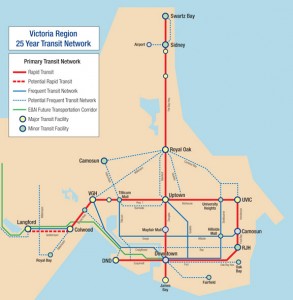UVic, after a decade of slowly drawing down their parking supply, and reaping the rewards for doing so, has decided to build a giant parkade on north-end of campus. Why is UVic proposing this now? What hass changed that they need so much new parking now? What happened to their much-vaunted sustainability?
The crazy part is that it isn’t even needed. Although there are a few place around the campus that might need a few fixes (such as Arbutus Rd.) there certainly isn’t some giant crisis that only a new parkade can solve. Nor is the proposed parkade in a good location – the north side of the. campus away from most of the buildings. UVic’s own 2010 Traffic Audit ([download id=”9″ format=”1″]something I worked on), says this
The results from the 2010 survey document the continued positive trends with decreases in total automobile-related trips and large increases in both pedestrian and bicycle trips.
One of the big questions is this – Why bring it forward now? I suspect that like the Baptist Housing folks who are replacing Oak Bay Lodge, UVic hoped that it could slide it under the radar in the quiet summer months. Not to mention getting approval before the next municipal election, due November 19th.
Even sadder is that UVic is currently stonewalling BC Transit on a new transit exchange at the university, something that BC Transit desperately needs to expand transit service for the students and staff of UVic, but cannot due to lack of space. BC Transit even started a process to get public opinion on where that transit exchange might go (something I wrote about in April). But UVic claims to have no funding for any new exchange. So where is the funding for this parkade coming from? It is explicitly tied to the sport centre, approved in a referendum of UVic students in 2009.
Thankfully, it appears that UVic run into no small amount of opposition from the local community, causing Saanich Council to delay the proposal until the fall.

